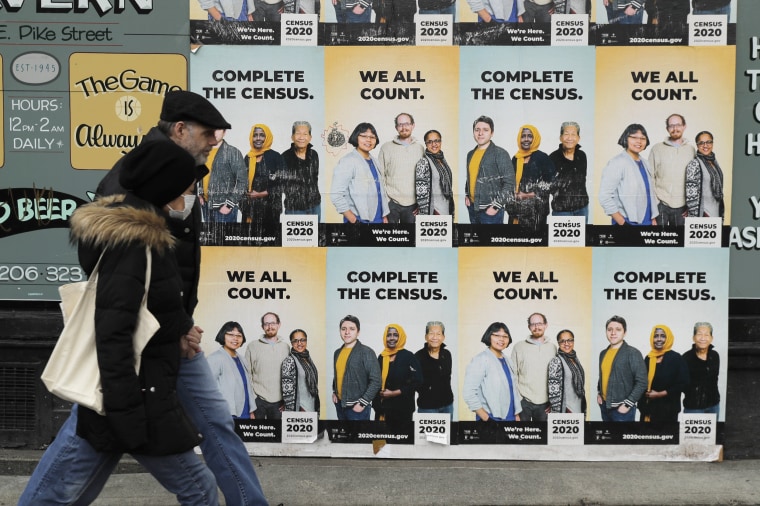Minnesota is leading the country in self-response rates to the 2020 census while Puerto Rico, a U.S. territory, is dead last, according to Census Bureau data.
Nearly 75 percent of Minnesota residents responded to the census by phone or mail or online, while just 34 percent of Puerto Rico residents self-responded.
Census workers across the country are rushing to count households that haven't yet responded before the agency is expected to halt all data collection efforts at the end of the month. The data submitted determine congressional seats and $1.5 trillion in aid, among other areas. Congressional Democrats, civil rights groups and a government watchdog have raised red flags that the truncated count may produce inaccurate results and could have serious consequences for vulnerable populations.
The in-person count has also faced a number of issues, including logistical hiccups, technical glitches and safety concerns from census workers.
The Census Bureau estimates that nearly 98 million households have self-responded — around 66 percent of all U.S. households — with millions more reached by enumerators. According to census data, around 95.8 percent of U.S. households had been counted as of Tuesday, leaving around 14 million households left. Many of those who remain unaccounted for live in hard-to-reach areas with little to no access to the internet.
The states or territories with the highest self-response rates (as of Tuesday) are:
- Minnesota, 74.7 percent
- Washington, 71.9 percent
- Wisconsin 71.8 percent
- Nebraska, 71.4 percent
- Iowa, 70.8 percent
- Michigan 70.8 percent
- Illinois, 70.6 percent
- Virginia, 70.6 percent
- Utah, 70.5 percent
- Maryland, 70.3 percent
The states or territories with the lowest self-response rates (as of Tuesday) are:
- Puerto Rico, 34.2 percent
- Alaska, 53.8 percent
- West Virginia, 55.9 percent
- New Mexico, 57.4 percent
- Maine, 57.8 percent
- Louisiana, 59.4 percent
- Montana, 59.6 percent
- Mississippi, 59.7 percent
- Vermont 60.0 percent
- South Carolina, 60.1 percent
- Arkansas, 60.2 percent
Missing among the lists are many of the nation's most populous states, including New York, California and Texas — all three of which have large or growing minority and immigrant populations. Native tribes, as well as Black, Asian and Latino Americans, have historically been undercounted.
The Census Bureau announced last month that it would end all of its counting efforts Sept. 30, a month earlier than previously expected. Although a federal judge recently ordered the bureau to temporarily stop following its plan to wind down operations early, a leaked internal Census Bureau document sent to the House Oversight Committee and obtained by NBC News this month warned that the agency already has far less time and fewer resources to review the data than in previous years.
The internal document warns that the "highly compressed" timeline, as well as limits on activities like door-knocking and data review, will lead to less accurate results.
Officials have previously said the count is ahead of schedule even though the agency is operating with half of the number of enumerators it did in past years.
The roughly 240,000 workers the agency has now are less than half the workforce of the 2010 census, which had 564,000, according to a Bureau of Labor Statistics report. The inspector general of the Commerce Department, which oversees the census, raised concerns in an Aug. 18 letter that a lack of enumerators presented the risk of not having a "complete and accurate" census.
Virginia Hyer, a spokesperson for the Census Bureau, said in an email that the agency took into account areas that have limited internet access and sent paper questionnaires to those areas. She said there is no clear explanation why some areas have higher response rates than others.
“There is no single cause for why some populations have higher response rates than others. Our research has shown that lack of knowledge about the importance and safety of the census can contribute to people not responding,” she said, adding that the agency created an outreach campaign.
The bureau said its director, Steven Dillingham, also sent a letter to all tribes whose borders remain closed to census takers because of Covid-19, asking for their help and permission for census takers to go door to door to collect responses on their reservations or do outreach by phone.
“We are determined to count everyone. Our focus right now is following up with those who have not yet responded, especially tribal communities,” the spokesperson said.
According to Census Bureau data, around 29 percent of households have so far been counted in follow-ups.
Tim Olson, the agency's associate director for field operations, defended the operation in a previous telephone interview and dismissed the concerns from critics. He said in the interview that the agency is now using the "best of the best" to count households in harder-to-reach areas of the country.
Some of the starkest discrepancies in response rates can be found in small towns.
The only two areas in the country with 100 percent self-response completion rates are a small suburb north of Fargo, North Dakota, called North River, which has a population of about 55 residents, and Balltown, Iowa, a 70-person town that is home to the state’s oldest restaurant.
Meanwhile, Aldora, Georgia, which has a population of 103, has a 0 percent self-response rate. And Fontana Dam, North Carolina, a village known for its tourist-attracting resort, has a 0.9 percent completion rate among its 33 residents.
The nation’s two largest cities, New York and Los Angeles, also rank low among cities, at 60 percent and 57.2 percent, respectively, far below the national average.
This story has been updated with new data as of Tuesday afternoon.

